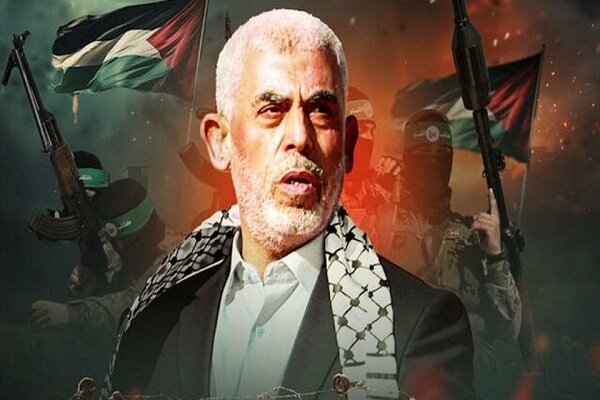According to Mehr News Agency, quoting Asharq Al-Awsat, Yahya Sinwar was born and raised in the Khan Younis refugee camp in Gaza after his family was displaced from the city of al-Majdal. He completed his early education in the camp’s schools and later earned a degree in Arabic Studies from the Islamic University of Gaza.
Even after his imprisonment, Sinwar continued his security and organizational activities inside Israeli prisons and served as the leader of Hamas prisoners.
Ismat Mansour, a former Palestinian prisoner affiliated with the Democratic Front who spent many years in Israeli jails, describes Sinwar as follows: “When you meet Sinwar, you see a simple, ordinary, and religious man. His religious background is evident in the way he builds relationships—he cannot interact without first taking a principled stance.”
Mansour adds that Sinwar rejected compromise and viewed any solutions or agreements only as tactical maneuvers.
Abdul Fattah Dolah, a former prisoner affiliated with Fatah who also spent many years in Israeli jails, first met Sinwar in 2006. He describes him as a social and compassionate person.
Salah al-Din Taleb, another Hamas member who shared a cell with Sinwar for years and was released alongside him, recalls his first meeting with “Abu Ibrahim” this way: “His modesty and cheerful relations with young men made him very approachable.” However, he adds that Sinwar’s security-oriented nature distinguished him from other Hamas leaders.
Security Obsession Inside Prison
In the mid-1990s, Hamas and its operational cells in the West Bank and Gaza suffered heavy blows — including the assassination of senior leaders such as Yahya Ayyash and Imad Akel by Israeli spy service, the mass arrest of activists, and the dismantling of many operational networks.
These developments deeply shook the movement and their effects extended even into Israeli prisons. It was during this period that Sinwar entered what fellow inmates called his “security obsession phase.”
Sinwar and the Shalit Negotiations
During the early 1990s, while still in Israeli prisons, the Izz al-Din al-Qassam Brigades — Hamas’ military wing — emerged and began a series of operations against Israeli military targets.
Inside the prisons, Sinwar developed connections with key figures from the military wing. After his release in 2011, these ties grew stronger, marking a new chapter in his career.
This deepening relationship with the Qassam Brigades meant that once the 2011 Gilad Shalit exchange deal was completed and “Abu Ibrahim” (Sinwar) and his comrades were released, he entered a new phase of leadership.
His younger brother, Mohammed Sinwar, was a senior commander in the military wing and had taken part in the operation that captured Israeli soldier Gilad Shalit and held him for years before the 2011 exchange.
Inside prison, Yahya Sinwar gained significant influence during the Shalit negotiation process. He played such a central role that at one point, the Israeli official in charge of the Shalit file came to the prison to negotiate directly with him, recognizing his major impact on the talks.
Sinwar’s Near-Death Experience
As the prisoner exchange negotiations gained momentum and neared completion, Sinwar fell critically ill, almost losing his life — a development that disrupted Israeli calculations.
Dolah recalls: “Sinwar was tough and always refused to go to the prison’s medical center.”
His condition deteriorated until he lost consciousness, forcing fellow prisoners to rush him to the clinic. His transfer to the Be’er Sheva prison infirmary caused panic among prison authorities, who immediately declared a state of emergency and locked down the entire section.
In an unprecedented move — since Israel had long ignored the health of Palestinian prisoners — a helicopter landed inside the prison compound and transferred Sinwar urgently to Soroka Hospital for immediate surgery.
Doctors discovered a benign brain tumor, which they quickly removed. Sinwar underwent what was described as a “highly complex and dangerous operation” that nearly cost him his life.
Israel’s exceptional response to Sinwar’s illness reflected its confusion during the Shalit talks and its deep fear that his deteriorating health might derail the deal at its final stage.
“Al-Qassam Brigades and Sinwar” After 2011
After his release in the 2011 prisoner exchange, Sinwar not only resumed his security responsibilities within Hamas but also strengthened his links with the movement’s military wing.
In 2012, he was elected to Hamas’ Political Bureau and immediately took charge of liaison with the Qassam Brigades. Ultimately, in 2017, he became the head of Hamas’ Political Bureau in Gaza.
Early Signs of the “Al-Aqsa Flood” in Israeli Prisons
Dolah says there was always a belief among prisoners that Sinwar was “destined for a major mission.”
This impression grew stronger through his speeches and messages to fellow inmates over the years.
With the Al-Aqsa Flood Operation and Israel’s ensuing genocide in Gaza, Israel came to view Sinwar as the central figure of confrontation, holding him entirely responsible for the operation.
MNA/6623010

